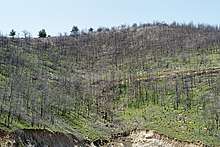Kastro, Thasos
Kastro (Greek: Κάστρο) is a small village in the interior of the Greek island of Thassos. It is believed to be the oldest village on the island. The village name comes from the old castle that existed here to protect the inhabitants (Kastro means "castle"). The village is located in the centre of the island, at a height of 450–500 m above sea level. It can be reached from Limenaria on an asphalt road or from Theologos on a dirt road.
According to the 2011 census, the population of Kastro was 9.[1]

History
The settlement was first mentioned in 1434 in connection with the establishment of a local fortress or citadel (acropolis) by Umberto Grimaldi, when Thassos was ruled by the Genoese Dorino I Gattilusio. The ruins of the citadel's wall can still be seen. Over the centuries, Kastro, like other mountain villages, was a refuge from pirates. After the fall of Constantinople in 1453 a large number of Greeks came to the island, and most settled in Theologos and Kastro. Under Ottoman administration, the place was known as Yenihisar (New Castle).
Because of its remote and inhospitable location it remained a poor settlement, and in 1856 had only 60 houses.[2]
In the late 19th century, the island's inhabitants started to move from mountain villages to the coast, transforming temporary fishermen's settlements into villages. Inhabitants of Kastro moved to the villages of Kalyvia and Limenaria. A similar thing happened to most mountain villages: Kazaviti (Megalos/Mikros Prinos) has Prinos, Rachoni has Skala Rachoniou, Theologos has Potos, etc. Many names of coastal villages on the island start with "Skala" ("ladder" in Greek), referring to the connection between the mountain village and its coastal village.
Buildings
Since the 1960s many of the buildings in the village have been rebuilt and restored.
The village has a small church dedicated to St Athanasius, which has the blazon of Gattilusio on one of the outside walls. The church was built in 1804, within forty days, with the help of all the inhabitants. The stones used to build the church came from the old castle's ruins. Gattilusio's blazon was added to the church's wall, but it was put upside down. In 1980, the church was declared a historical monument, being one of the oldest churches in Thassos.
Every 18 January the church continues to attract people to celebrate the memory of St Athanasius.
On the remains of the old citadel (acropolis) is the village's ossuary, still used to keep skeletal remains of the deceased inhabitants.
References
- Census 2011, Greek Statistical Office (ΕΛ.ΣΤΑΤ) Archived 2013-12-25 at the Wayback Machine (Excel document, 2.6 MB)
- Georges Perrot: Memoire de l’ile de Thasos (Archives des missions scientifiques et littéraires; vol 1). Imprimerie Impériale, Paris 1864, p70.
External links
![]()